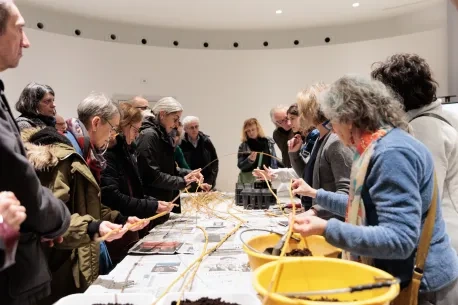Zoom-in 1: Housing the Generations: Shared Solutions for a Shifting Demographic

The idea of homeowners exchanging properties to match evolving needs across generations has fascinated housing experts and communities alike. Particularly, the notion where older adults, often homeowners of large family-sized properties, transition from their long-held residences into smaller, communal, or cohousing environments, while younger families move into the newly vacated homes. This concept underpins several emerging collaborative housing patterns, especially in countries with ageing populations and growing housing demand from young families. These ideas call for great promise for housing market efficiency, unlock unused space, bolster community vitality and intergenerational solidarity. However, outright "swaps" between these two groups are uncommon in a formal sense.
In SHARE Fuenlabrada, the "Solidarity Housing System” experiments in formalising this exchange, linking elder participants’ release of under-utilized homes, often too big for a single or a couple of elderly homeowners and not tailored to their future needs, to increased rental housing stock for young people. The former school, repurposed as a housing complex, provides at least 20 long-term dwellings catering to elderly residents, supported by the Programme for the Early Protection of Autonomy (PEPA). At the same time, approximately 40 to 60 young tenants are expected to benefit from refurbished flats in the city centre, with the condition of engaging in community participation and solidarity activities alongside seniors.
Across Europe, collaborative initiatives have emphasized mixed-age integration, mutual care and intergenerational support, with various programmes matching seniors seeking assistance and reduced rent for students or younger people who offer light support and companionship ( e.g. ensemble2générations FR; 1Toit2Ages, BE; et al. ), but few cases allowing older adults to downsize while remaining engaged in vibrant social settings.
Taking a close look at Spain, several pioneering initiatives illustrate the diverse range of experimental affordable and social housing solutions, also geared toward seniors cohabitation improving care support in ageing, leveraging community, financial innovation, and cooperative management. An article from Feb. 2025 EL PAÍS titled "Cohousing projects to ease Spain’s real estate crisis" argues that cohousing is a promising alternative model to address the severe housing shortage and affordability crisis in Spain, and practices are booming, with a focus on aging and intergenerational approaches.
One notable grassroots example is the Senior Cooperative Housing in Barcelona known as Can70, a project grounded in the principles of ageing in place and collective empowerment. Supported by the scheme of Sostre civic ( which won the ERHA award in 2025), the project tailored primarily for women aged 55 to 70, Can70 employs a cooperative ownership model based on usufructuary rights—a legal arrangement where the residents have the right to use and enjoy the property without owning its market value, prioritizing use-value over market-value. This structure protects participants from speculative market pressures and aligns with the cooperative’s goals of social and financial sustainability. Can70 benefits from a 99-year public land lease and municipal subsidies, which reduce costs substantially for residents and help stabilize housing affordability. Architecturally, collaborative workshops ensured the design balances private living spaces with shared areas that promote community engagement and autonomy.
Another innovative financial model from Spain is Pensium, a private-sector solution that enables elderly individuals to finance long-term care through rental income optimization without relinquishing ownership of their properties. Unlike traditional reverse mortgages or life annuities, Pensium manages the rental of the senior’s unoccupied property, advancing rental equivalent payments—often up to twice the projected rent—to cover assisted living or in-home care costs. The property remains in the owner’s name, and Pensium assumes responsibility for maintenance, tenant sourcing, and insurance. This arrangement offers seniors immediate liquidity and peace of mind, obviating the need to sell or mortgage their homes. Financially, Pensium charges modest interest and service fees but removes the risks associated with conventional financial products tied to home equity. The rental income-generated repayments gradually amortize the advanced funds, and any surplus after repayment benefits the family. The program allows flexibility for early termination or adjustment in response to life changes, reflecting sensitivity to seniors’ dignity and needs.
Complementing these ownership and financial innovations are cooperative rental models such as the Lloguem! Yes, We Rent! initiative in the city of Mataró, Spain. This model, even though it does not specifically target an age-group is an interesting inspiration for SHARE, especially for managing the solidarity housing stock for youth. The project engages both property owners and tenants within a social and solidarity economy framework, refurbishing vacant apartments using workforce integration programs and guaranteeing rental income to landlords through a dedicated fund, thereby addressing vacancy and affordability simultaneously. Tenant cooperatives manage these properties, creating a participatory rental market that sustainably addresses housing challenges at the grassroots level. Such cooperative management fosters mutual responsibility and creates environments where rental housing becomes a stable and socially embedded option, beneficial to both elderly owners considering downsizing and younger tenants seeking affordable homes.
Beyond Spain, similar cooperative senior living projects illustrate the potential of community-oriented senior housing. One notable example is the Balancen community in Ry, Denmark, - one of the most prominent countries in piloting collaborative housing models- specifically designed to support seniors aging in place within a communal environment, or Mehrgenerationenhäuser (multi-generational houses) in Germany that integrate social centers, childcare, and living spaces to encourage intergenerational exchange outside of direct home swapping, achieving strong intergenerational cohesion and support networks. While some of these examples tend to be less accessible to lower-income individuals, they demonstrate how cooperative living supports autonomy, comfort, and social engagement for seniors in a collective setting.
In Brussels, the CALICO (Care and Living in Community) project illustrates a gender-inclusive and intergenerational cohousing innovation. Supported by the Community Land Trust model, CALICO removes the land cost factor from housing provision, ensuring long-term affordability for vulnerable groups, including elderly women and single mothers. The project comprises three cohousing clusters equipped with shared care facilities, such as birth and end-of-life care centers integrated into the community governance framework. CALICO’s design promotes collective empowerment and mutual care, pioneering a holistic approach that combines housing with embedded social and health services to address diverse lifecycle needs. SHARE project is also learning from this projects trought the URBACT network Cities4cohousing.
Architectural and design collaboration also plays a crucial role in realizing sustainable cohousing and senior housing initiatives in Spain. Projects like Trabensol in Torremocha de Jarama (Spain) and Cirerers in Barcelona emphasize democratic governance, ecological building, and community integration. Trabensol is a self-managed senior community with over 50 apartments clustered around shared social spaces, where residents actively participate in decision-making and mutual support, promoting active ageing.
Returning to the SHARE project in Fuenlabrada, its approach stages an incremental municipal effort to formalize intergenerational housing exchange, drawing selectively from existing models while testing new logistical and governance frameworks. Success depends on the alignment of multiple complex factors—legal protections that prevent dispossession, financial mechanisms that unlock equity without eroding control, rental frameworks that balance affordability with private ownership, inheritance, taxation et al. To date, these elements rarely converge at scale. SHARE's ongoing pilot offers an instructive opportunity to observe how far local experimentation can go in addressing systemic housing mismatches across generations without reproducing market inefficiencies or social inequities under a new guise.
This Zoom-in has been inspired by the background report of the Municipal Housing Institute of Fuenlabrada, drafted in 2024 basic input for the kick-of of the SHARE Project.
About this resource
The European Urban Initiative is an essential tool of the urban dimension of Cohesion Policy for the 2021-2027 programming period. The initiative established by the European Union supports cities of all sizes, to build their capacity and knowledge, to support innovation and develop transferable and scalable innovative solutions to urban challenges of EU relevance.
Similar content




